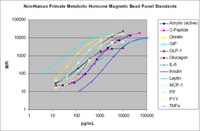Renin-angiotensin system blockers protect pancreatic islets against diet-induced obesity and insulin resistance in mice.
Frantz, ED; Crespo-Mascarenhas, C; Barreto-Vianna, AR; Aguila, MB; Mandarim-de-Lacerda, CA
PloS one
8
e67192
2013
Show Abstract
The associations between obesity, hypertension and diabetes are well established, and the renin-angiotensin system (RAS) may provide a link among them. The effect of RAS inhibition on type 2 diabetes is still unclear; however, RAS seems to play an important role in the regulation of the pancreas and glucose intolerance of mice fed high-fat (HF) diet.C57BL/6 mice fed a HF diet (8 weeks) were treated with aliskiren (50 mg/kg/day), enalapril (30 mg/kg/day) or losartan (10 mg/kg/day) for 6 weeks, and the protective effects were extensively compared among groups by morphometry, stereological tools, immunostaining, Western blotting and hormonal analysis.All RAS inhibitors significantly attenuated the increased blood pressure in mice fed a HF diet. Treatment with enalapril, but not aliskiren or losartan, significantly attenuated body mass (BM) gain, glucose intolerance and insulin resistance, improved the alpha and beta cell mass and prevented the reduction of plasma adiponectin. Furthermore, enalapril treatment improved the protein expression of the pancreatic islet Pdx1, GLUT2, ACE2 and Mas receptors. Losartan treatment showed the greatest AT2R expression.Our findings indicate that ACE inhibition with enalapril attenuated several of the deleterious effects of the HF diet. In summary, enalapril appears to be responsible for the normalization of islet morphology and function, of alpha and beta cell mass and of Pdx1 and GLUT2 expression. These protective effects of enalapril were attributed, primarily, to the reduction in body mass gain and food intake and the enhancement of the ACE2/Ang (1-7) /Mas receptor axis and adiponectin levels. | Western Blotting | 23894285
 |








